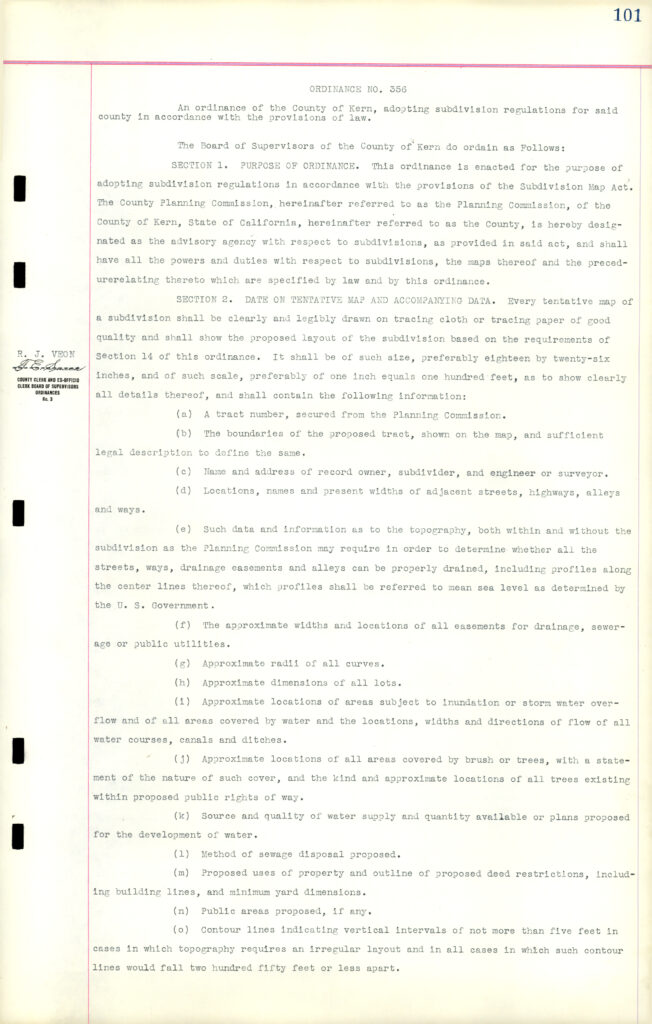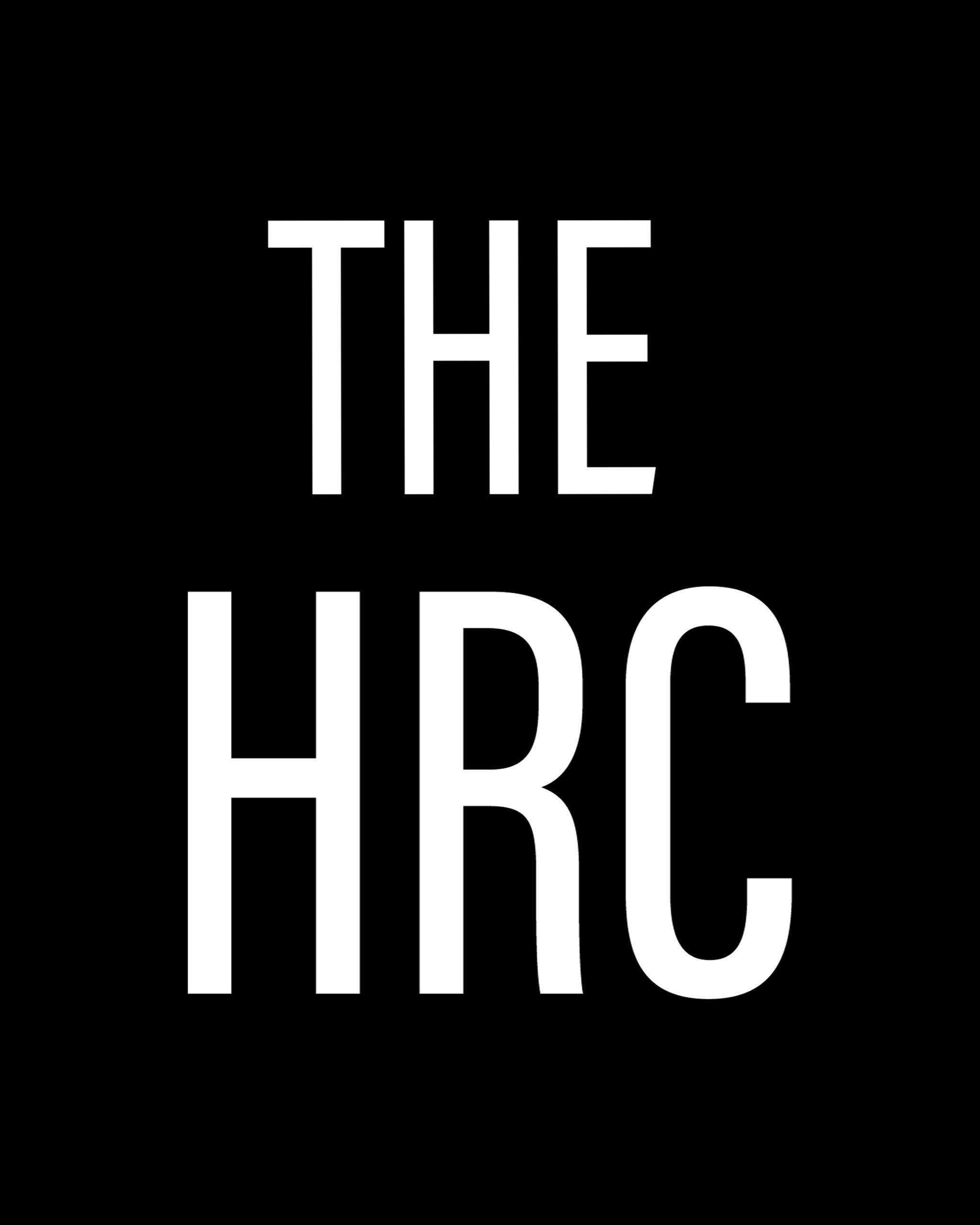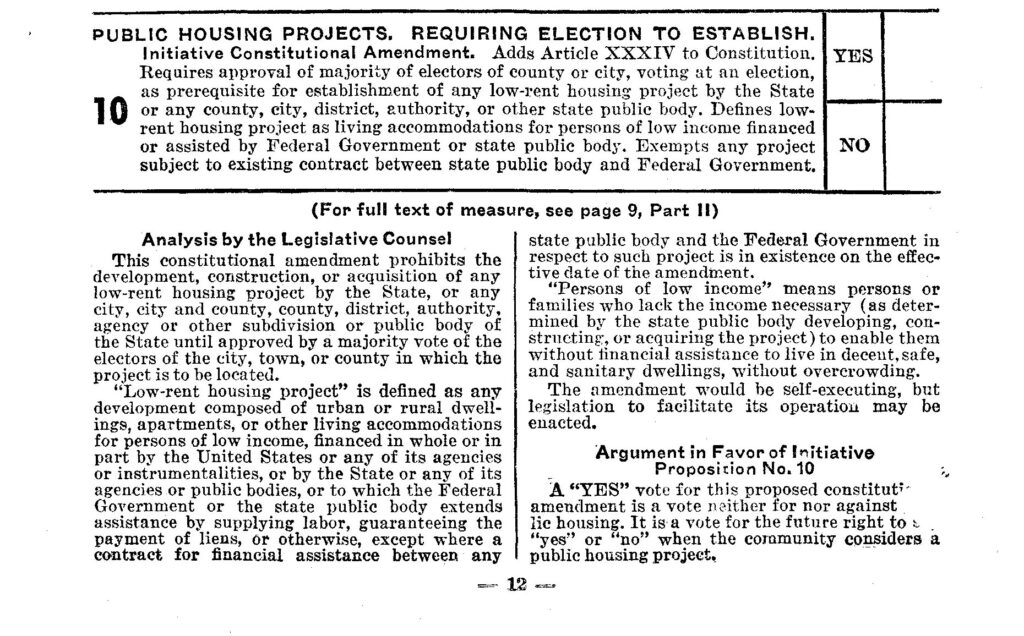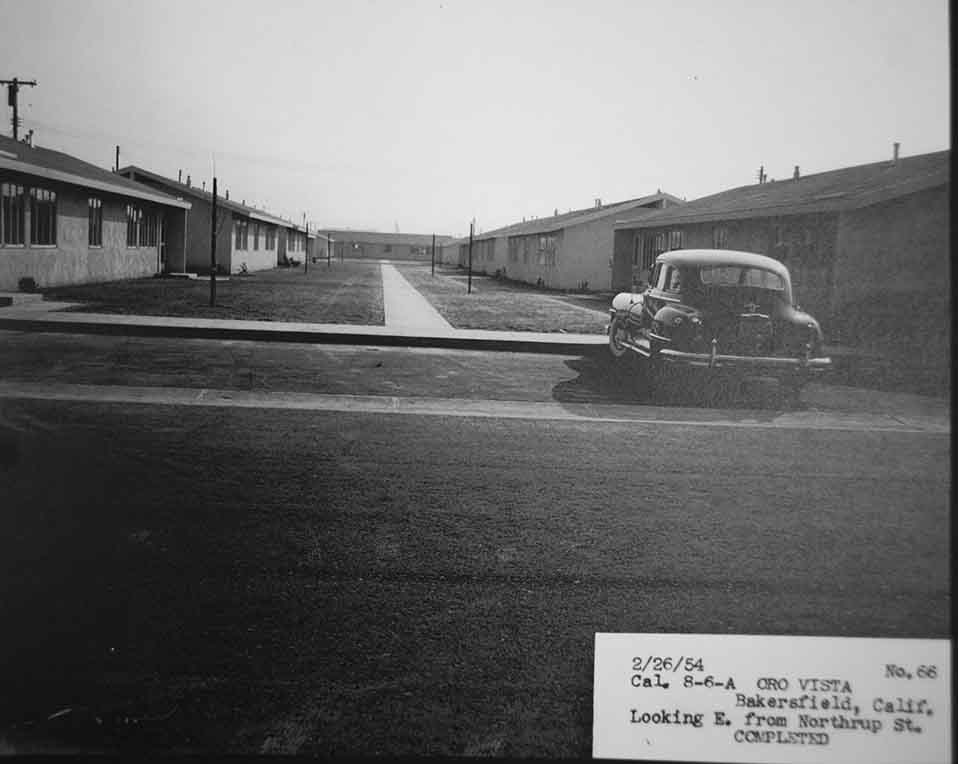Before 1938 – Buying on Contract – Covenants – Covenant Database – East Bakersfield
Education – Eminent Domain – Moving into a Neighborhood – Neighborhoods
Public Housing – Resources – Rumford Fair Housing Act – Suburban Expansion – Zoning
Zoning- Development of Codes in Kern County
In the 1930s, the Kern County Board of Supervisors passed a series of zoning ordinances, introducing the first restrictions on land use and home development. On January 20, 1932, the Board passed Ordinance 244, instructing the planning commission to introduce zoning and district plans for applying to certain construction of buildings and alterations. The next ordinance (245 ) created the Planning Commission for the County of Kern. Ordinance 247, amended Ord. 244 and introduced restrictions on modifying or constructing smokestacks, flagpoles, tanks, radio stations, oil derricks, towers, and buildings in the unincorporated areas of the county.
Ordnance 249 was the most comprehensive zoning law put into place in 1933, which created zone district sections 3A, 3B, 3C, 3D, and 3E. Ordinance 249 was the first land restriction to establish a “setback” standard, the set distance from home to the road, home desirability, and permitted building modifications.
Definitions of the additions to the first Modern Zoning Code:
3A- One family, two families, multiple dwellings, hotels, and auto camps.
Uses: Schools, libraries, parks, playgrounds, churches, agriculture (except hogs), stores, shops, offices, retail, automotive sales (no dismantling or wrecking), and only indoor used car sales.
3B- highway space, traffic movement, and pedestrian passage. Amended by Ordinance 269
3C- Repairs to agricultural improvement, building, or repairs above $25 dollars require a permit. Modified by Ord 252.
3D- Improvements under 3C require plans of elevations, not be obnoxious, be harmonious with the building of Kern County, and submit plans to the planning department.
3E- Prescribe standardized forms for applications and appeals, allow for County enforcement by fine or jail, and allow for County abatement or removal of nuisance.
3F- Added by Ord 252, establishing an interim district for housing in Castaic.
3G- Added by Ord 257, establishing rules for mausoleums, cemeteries, and crematoriums.
3H- Added by Ord 282, establishing residential blocks for single-family housing.
3I- Added by Ord 282, 3H applies to Wasco.
Ordinance 282 was the first law to include morals and public health:
This ordinance is hereby declared to be an urgent measure necessary for the immediate preservation of the public health, morals, comfort, and general welfare, and shall take effect immediately. The conditions constituting such urgency are as follows: The Federal Housing Administration has undertaken to insure loans for the construction of adequate housing… Under the terms prescribed by the Federal Housing Administration, property is ineligible for such insured loans unless the neighborhood of such property is adequately protected against the instruction of uses which would impair the residential character of such neighborhoods” 1935.
Later, Ordinances added more complex laws and shifted to modernity, setting in stone the tract era and standardized and suburban home building. Ordinance 327 added planning for districts, terms and procedures, regulations, building lines, and supervision for county homes. This was the most “modern” zoning ordinance in 1937. This led to Ordinance 356, which established rules related to the “Subdivision Map Act” in 1940. This was the most comprehensive zoning law then, spanning 12 pages. The Subdivision Map Act of 1940 required local governments to establish regulations to guide subdivisions and grant powers to local governments to ensure that subdivisions occur (subjectively) in an orderly and responsible manner. Ordinace 354 included all the modern requirements for subdivision building: Tract number, boundaries, data, mapping, surveying, street names, recording, availability of modern amenities like gas/electricity/sanitary plumbing, master plans for subdivision with streets, and recommendations of parks, schools and public building sites for public use.

Zoning- The Fight for Public Housing 1950s
In December of 1950, the Sunset and Mayflower neighborhoods were annexed into the city of Bakersfield. The community had secured enough votes to be added to city boundaries, guaranteeing city services like sewer, street lights, paved roads, and trash pickup. The contract for Oro Vista was signed in early 1950, but the opening would not happen until 1954. The Bakersfield Realty Board supported Proposition 10 of 1950, which would require a majority of electors of a county or city to approve public housing. Oro Vista was planned in the Sunset community, adjacent to Adelante Vista.
A local Bakersfield realty agent sued on the basis of Proposition 10 and effectively stalled the building of Oro Vista in 1951. In January 1951, the City of Bakersfield entered in to a cooperation agreement with the Housing Authority of Kern County and later rescinded the agreement in March 1952, with the support and petition of the Bakersfield Realty Board. The Bakersfield earthquake happened in August of 1952. The city entered into a second cooperation agreement, reaffirming their cooperation in October 1952. The lawsuit and appeal carried into 1954, when it was established that Oro Vista was not subject to Proposition 10, since the contracts and loans were issued in 1949 and again in early 1950.
A separate injunction in 1954 also accused the City of Bakersfield of rezoning against the interest of the majority of the population. Mayflower and Sunset was Zoned R1 (One Family) to R2 (Two Family) housing. The second lawsuit determined that the State of California, under the Health and Safety Codes and The Housing Authority Law, had the power to change zoning without the opinion of the city’s electorate or public referendum, not limited to interference by municipal or county administration.



